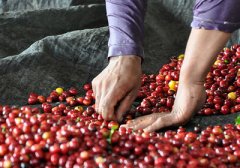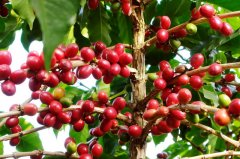The reason why Colombian coffee is famous in the world: superior natural conditions and unique processing methods.

For professional baristas, please follow the coffee workshop (Wechat official account cafe_style)
Flavor characteristics of Colombian Coffee
Colombian coffee is of high quality and delicious, famous all over the world, with nutty aroma, the best balance, soft and mellow taste.
The country's coffee-producing areas are located in the Andes, where the climate is mild and the air is humid. Colombia has three Codiera mountains running north and south, right into the Andes. Coffee is grown along the highlands of these mountains, and the steps provide a diverse climate.
This means that the whole year is the harvest season, and different kinds of coffee mature one after another at different times.
Coffee comes from Ethiopian curry. In Colombia, it was brought by a priest from the French Antilles via Venezuela in 1808. At present, Colombia is the fourth largest coffee producer in the world, behind Brazil, Vietnam and Indonesia. There are four types of coffee trees in the world, namely, ARABICA, ROBUSTA, LIBERICA and EXCELSA, and there are many varieties under each. A large number of Arabica coffee trees are planted in Colombia, especially Colombian varieties. This is a new variety bred by Colombian agronomists themselves, with strong resistance to diseases and insect pests and high yield.
Superior natural conditions
Just as Chile's geography meets all the criteria for producing fine wines, Colombian Coffee is world-famous and has its own reasons:
First, the natural conditions are superior. The coffee tree was originally intended to grow in the tropics within the Tropic of Cancer, at an altitude of 800-1600 meters above sea level, while Colombia is located north of the equator and south of latitude 13 degrees north. Its famous coffee triangle, the three provinces of coffee, is about 1200-1400 meters above sea level, where the Andes stand. Rain Water is moderate, sunny and free of the threat of frost, and the natural conditions may be better than in Brazil. The coffee trees all over the mountains are green, ranging from tall shrubs to 4 or 5 Michael's. From afar, they seem to be in the tea forest of China.
Unique processing techniques
Second, the processing technique is unique. Coffee trees are raised from coffee seedlings. Coffee beans, which are used as breeding, are picked in the middle of the coffee tree and are full of grains and luster. The beans are cultivated in a specific breeding bag, and slowly, they send out young seedlings, which at first look a bit like mung bean sprouts and matchsticks, and then grow a pair of new leaves every month, which can be transplanted to the ground six months later. Coffee beans are produced two years later, and a coffee tree usually grows for about eight years, then it is cut down to grow again, and after another eight years, new coffee seedlings need to be planted. The fruit and flowers on the coffee tree can exist at the same time, the flowers are white, a bit like jasmine, but there is no fragrance. The fruit is the size of a cherry, with a smooth surface, some red and some yellow, with a pair of coffee beans inside. Colombian coffee is washed, the pulp and peel are removed, and fermented to make a good fertilizer, while coffee beans are soaked in water, remove the mucus, then dry, remove the skin from the beans, and roast. The longer the baking time and the higher the temperature, the more mellow the coffee taste, and the shorter the time, the softer the taste. Moreover, Colombian coffee is all picked manually. It is picked twice in May and October every year, and only ripe coffee fruits can be picked. Unlike in Brazil, where coffee is picked at one time by machines, it is picked indiscriminately, and there is no washing procedure for processing. Kung fu is not at home, so the taste is not good enough.
Perfect organizational system
Third, the organizational system is perfect. Colombia established the National Federation of Coffee makers a long time ago. Coffee farmers in various provinces hand in their results to the organization after the harvest. The federation has set up branches in many countries to promote coffee, and there are certain strategies in operation and marketing. Over time, the fame has also grown, and the business has become better and better, making Colombian coffee more and more popular in the world. Today, 25% of Colombia's coffee is exported to Germany, and a considerable amount of it is exported to the United States. Many of Starbucks' coffee comes from Colombia. The federation's Juan Valdez (JUAN VALDEZ, the image of a local coffee farmer) Coffee is Colombia's leading brand, the best-known and naturally the most expensive. It is said that this brand selects the best coffee beans and gives the rest to other brands to process. I say so, but I don't believe it. Because such as SELLO ROJO, OMA and other brands or provincial brands, there are a lot of local people to buy, the taste is not bad. Maybe the first brand is for export, and the other is for local people's own use, after all, the latter is cheaper. The coffee we tasted at the local coffee farm was made by the hostess. It was very fresh and tasted the most authentic. It didn't need to add sugar or companion.It was full of fragrance. She is thinking about getting rid of the federation and creating her own brand in the future. after all, her coffee area has as much as 75 hectares, which can be regarded as a landlord's old fortune.
Before, I never felt how delicious the coffee was. Knowing that the process was so long and arduous, I couldn't help paying homage to the coffee served. The respect was for the process itself.
Important Notice :
前街咖啡 FrontStreet Coffee has moved to new addredd:
FrontStreet Coffee Address: 315,Donghua East Road,GuangZhou
Tel:020 38364473
- Prev

Classification of Colombian Coffee the best coffee grade in Colombia-Supremo 18
For the exchange of professional baristas, please follow the coffee workshop (Wechat official account cafe_style) Colombian Coffee grading system: Colombian coffee is divided into three grades: Supremo, Excelso, Extra and so on. Supremo is the most advanced, followed by Extra, designed for commercial coffee buyers is Excelso, by Supremo and Extra
- Next

Effect of raw bean treatment on coffee bean flavor what treatment has the best flavor
The exchange of professional baristas please follow the coffee workshop (Wechat official account cafe_style). Ethiopia Humbera Manor Holy Lion single Farm slow drying 105batches of Ethiopia Hambela Benti Nenqua G1 Washed SFP Lot 105tried the sun-dried version of Humbera and found that the bean merchant also entered the washed version. There is an interesting Ethiopian coffee in the past year or two.
Related
- Detailed explanation of Jadeite planting Land in Panamanian Jadeite Manor introduction to the grading system of Jadeite competitive bidding, Red bid, Green bid and Rose Summer
- Story of Coffee planting in Brenka region of Costa Rica Stonehenge Manor anaerobic heavy honey treatment of flavor mouth
- What's on the barrel of Blue Mountain Coffee beans?
- Can American coffee also pull flowers? How to use hot American style to pull out a good-looking pattern?
- Can you make a cold extract with coffee beans? What is the right proportion for cold-extracted coffee formula?
- Indonesian PWN Gold Mandrine Coffee Origin Features Flavor How to Chong? Mandolin coffee is American.
- A brief introduction to the flavor characteristics of Brazilian yellow bourbon coffee beans
- What is the effect of different water quality on the flavor of cold-extracted coffee? What kind of water is best for brewing coffee?
- Why do you think of Rose Summer whenever you mention Panamanian coffee?
- Introduction to the characteristics of authentic blue mountain coffee bean producing areas? What is the CIB Coffee Authority in Jamaica?

